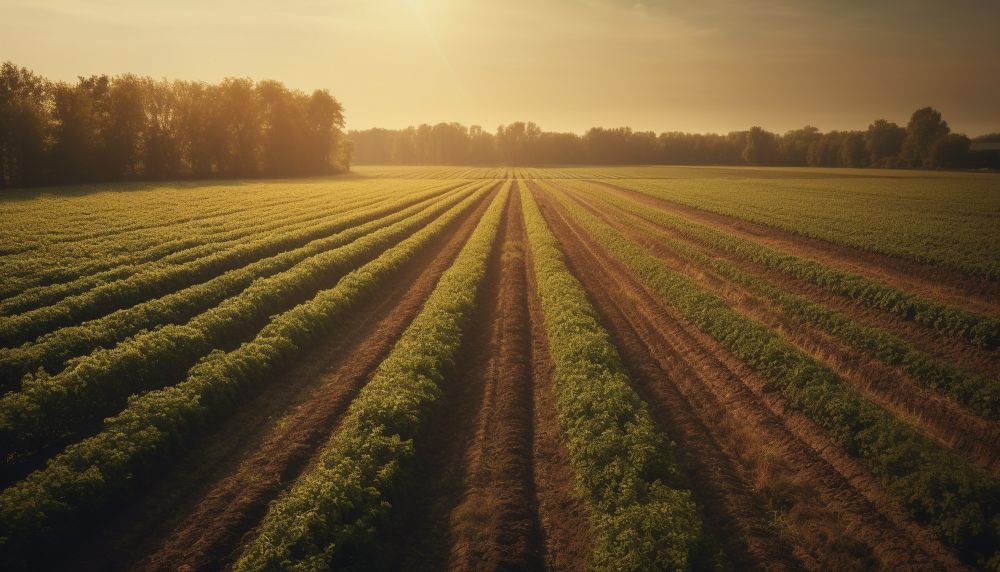Regenerative Agriculture: Reviving the Land


Cut through the green tape
We don't push agendas. At Net Zero Compare, we cut through the hype and fear to deliver the straightforward facts you need for making informed decisions on green products and services. Whether motivated by compliance, customer demands, or a real passion for the environment, you’re welcome here. We provide reliable information—why you seek it is not our concern.
Сonventional agricultural practices have often led to significant environmental degradation, including soil erosion, loss of biodiversity, and increased greenhouse gas emissions. In response to these challenges, regenerative agriculture has emerged as a promising approach that sustains and actively improves ecosystems' health.
What is Regenerative Agriculture?
Regenerative agriculture is a holistic farming approach that seeks to restore and enhance the natural ecosystems within agricultural landscapes. Unlike conventional agriculture, which often focuses on maximizing short-term yields through intensive inputs like synthetic fertilizers and pesticides, regenerative agriculture prioritizes long-term environmental health and resilience. The goal is to create self-sustaining farming systems, improve soil health, increase biodiversity, and sequester carbon, thereby addressing some of the most pressing environmental challenges of our time.
The Scientific Principles Behind Regenerative Agriculture
Soil Microbiology: The Foundation of Soil Health
Soil is not merely an inert substrate for plant roots; it is a living, dynamic ecosystem teeming with microorganisms such as bacteria, fungi, protozoa, and nematodes. These microorganisms play a critical role in maintaining soil health, nutrient cycling, and plant growth.
Soil Microbial Communities: Healthy soils are characterized by a diverse and active microbial community. Bacteria and fungi are essential for decomposing organic matter, breaking it down into simpler compounds that plants can absorb as nutrients. Mycorrhizal fungi, in particular, form symbiotic relationships with plant roots, extending their reach into the soil and improving nutrient uptake, especially phosphorus.
Nutrient Cycling: Microorganisms are integral to the nutrient cycling process, converting organic matter into forms of nitrogen, phosphorus, and other essential elements that plants can readily absorb. This process reduces the need for synthetic fertilizers and enhances soil fertility over time.
Disease Suppression: A diverse soil microbiome can help suppress soil-borne plant diseases by outcompeting or inhibiting pathogenic organisms. This natural form of pest control reduces the reliance on chemical pesticides, which can harm beneficial soil life.
Soil Structure: Microbial activity contributes to the formation of soil aggregates, which improve soil structure, enhance water infiltration, and reduce erosion. Bacteria produce sticky substances called exopolysaccharides that help bind soil particles together, while fungi, especially mycorrhizae, help form stable soil aggregates.

Carbon Sequestration: A Climate Mitigation Strategy
Through various practices, regenerative agriculture can help draw down atmospheric carbon dioxide (CO2), and store it in the soil as organic carbon.
Photosynthesis and Carbon Fixation: Plants naturally capture CO2 from the atmosphere through photosynthesis, converting it into organic matter that becomes part of the plant structure. When plants die or shed leaves and roots, this organic matter becomes incorporated into the soil.
Soil Organic Carbon: Soil organic carbon (SOC) is a key component of soil organic matter, which includes decomposed plant and animal materials as well as microbial biomass. Practices like cover cropping, composting, and reduced tillage increase the input of organic material into the soil, thereby boosting SOC levels.
Carbon Sequestration Processes: Carbon sequestration in soil occurs through two primary processes: stabilization and aggregation. Stabilization involves the protection of organic carbon within soil particles, making it less accessible to microbes and therefore less likely to be decomposed and released as CO2. Aggregation, as mentioned earlier, is facilitated by microbial activity and the physical binding of organic matter to soil particles, further protecting carbon stores.
Long-term Carbon Storage: The potential of soil to act as a long-term carbon sink depends on the balance between carbon inputs (e.g., plant residues, compost) and outputs (e.g., decomposition, erosion). Regenerative practices that enhance soil health, such as no-till farming and perennial cropping, can increase the amount of carbon stored in the soil over time, contributing to climate change mitigation.
Biodiversity: Building Resilient Ecosystems
Biodiversity is a cornerstone of regenerative agriculture, supporting ecosystem services that are essential for sustainable farming. A diverse agricultural ecosystem is more resilient to environmental stresses, such as pests, diseases, and climate variability.
Above-Ground Biodiversity: Above-ground biodiversity includes the variety of plants, animals, and insects within a farm ecosystem. Diverse plant species, such as those found in polycultures or agroforestry systems, create habitats for beneficial insects and pollinators, reduce the spread of pests and diseases, and improve overall ecosystem stability.
Below-Ground Biodiversity: Below-ground biodiversity refers to the variety of microorganisms in the soil. A diverse soil microbiome enhances nutrient cycling, disease suppression, and carbon sequestration, as discussed earlier. Additionally, different plant species support different microbial communities, which in turn promote soil health and fertility.
Functional Diversity: Functional diversity refers to the range of different biological processes and functions performed by organisms within an ecosystem. In regenerative agriculture, this might include different plant root architectures that improve soil structure, diverse crop rotations that break pest and disease cycles, and varied microbial communities that enhance nutrient availability. The greater the functional diversity, the more resilient the ecosystem is to disturbances.
Ecosystem Services: Biodiversity underpins many ecosystem services, such as pollination, pest control, water purification, and soil formation. By promoting biodiversity, regenerative agriculture enhances these services, leading to more productive and sustainable farming systems.
Scientific Evidence and Outcomes
The effectiveness of regenerative agriculture is supported by a growing body of scientific research. Studies have shown that regenerative practices can significantly increase soil organic carbon levels, improve water retention, and enhance biodiversity. For example, research has demonstrated that regenerative grazing practices can increase SOC by 0.3 to 1.0 metric tons per hectare per year, depending on soil type and climate. Similarly, diversified cropping systems have been shown to increase yields and reduce pest pressures compared to monocultures.
In terms of carbon sequestration, it is estimated that globally, regenerative agricultural practices could sequester between 1.5 to 3 billion metric tons of CO2 annually, making a substantial contribution to mitigating climate change. Moreover, farms practising regenerative agriculture often exhibit greater resilience to climate extremes, such as drought and flooding, due to improved soil health and water management.

Regenerative Agricultural Practices
1. Cover Cropping
Cover cropping involves planting crops that are not intended for harvest but rather to cover the soil during periods when it would otherwise be bare. Common cover crops include legumes like clover, grasses like rye, and other plants that can grow quickly.
Benefits:
Soil Protection: Cover crops protect the soil from erosion by wind and water.
Soil Fertility: Many cover crops, especially legumes, fix nitrogen in the soil, improving its fertility for subsequent crops.
Weed Suppression: Cover crops can outcompete weeds, reducing the need for herbicides.
Organic Matter: When cover crops decompose, they add organic matter to the soil, enhancing its structure and ability to retain water.
2. No-Till and Reduced Tillage
No-till and reduced tillage farming minimize or eliminate the disturbance of the soil that occurs with traditional ploughing. Instead of turning over the soil, crops are planted directly into the previous crop’s residue.
Benefits:
Soil Structure: Minimizing soil disturbance preserves its natural structure, which helps retain moisture and reduces erosion.
Carbon Sequestration: No-till practices help sequester carbon in the soil, contributing to climate change mitigation.
Biodiversity: Reduced tillage maintains habitats for soil organisms, enhancing biodiversity below ground.
Energy Savings: Less tillage means less fuel used for machinery, reducing the farm’s carbon footprint.
3. Rotational Grazing
Rotational grazing involves moving livestock between different pastures or paddocks in a planned sequence. This allows each area to rest and regenerate before being grazed again.
Benefits:
Soil Health: Rest periods allow plants to regrow, leading to healthier pastures and deeper root systems that improve soil structure.
Biodiversity: Diverse plant species can thrive under rotational grazing, supporting a wider range of insects and wildlife.
Nutrient Cycling: Livestock manure is distributed more evenly across the land, enhancing soil fertility without the need for synthetic fertilizers.
Resilience: By preventing overgrazing, rotational grazing improves the land’s resilience to drought and other stresses.
4. Agroforestry
Agroforestry integrates trees and shrubs into agricultural landscapes. This practice can take many forms, such as alley cropping (planting rows of trees between rows of crops), silvopasture (combining trees with pasture for livestock), and forest farming (cultivating crops under a forest canopy).
Benefits:
Biodiversity: Trees provide habitats for a wide range of species, increasing biodiversity on the farm.
Soil Health: Tree roots help stabilize soil, prevent erosion, and contribute to soil organic matter.
Microclimate: Trees can modify the microclimate, providing shade, reducing wind speed, and protecting crops from extreme temperatures.
Carbon Sequestration: Trees sequester significant amounts of carbon, making agroforestry a powerful tool in the fight against climate change.
5. Composting
Composting is the process of decomposing organic waste materials, such as crop residues, food scraps, and manure, into nutrient-rich compost that can be applied to fields.
Benefits:
Soil Fertility: Compost adds essential nutrients and organic matter to the soil, improving its fertility and structure.
Water Retention: Compost improves the soil’s ability to retain moisture, reducing the need for irrigation.
Reduced Waste: Composting recycles organic waste materials, reducing the need for chemical fertilizers and minimizing waste sent to landfills.
Disease Suppression: The beneficial microorganisms in compost can help suppress soil-borne diseases, reducing the need for chemical pesticides.
6. Crop Rotation
Crop rotation involves growing different types of crops in a sequence on the same piece of land. For example, a farmer might rotate between grains, legumes, and root crops.
Benefits:
Pest and Disease Control: Rotating crops disrupts the life cycles of pests and diseases, reducing their impact without relying on chemical controls.
Nutrient Management: Different crops have different nutrient needs and contribute various nutrients back to the soil. For example, legumes fix nitrogen, benefiting subsequent crops.
Soil Health: Crop rotation prevents the depletion of specific nutrients, maintains soil fertility, and reduces the likelihood of soil degradation.
Weed Management: Varying the crops can help manage weed populations by interrupting their growth cycles.
7. Holistic Planned Grazing
Holistic planned grazing is a decision-making framework that takes into account the entire ecosystem, including weather patterns, livestock needs, and land conditions. This method often involves intensive rotational grazing but with a focus on adapting to changing conditions.
Benefits:
Enhanced Soil and Plant Health: By carefully planning grazing, farmers can ensure that livestock contribute positively to the land, improving both soil and plant health.
Increased Biodiversity: Properly managed grazing promotes a diversity of plant species and creates habitats for wildlife.
Carbon Sequestration: Managed grazing can enhance carbon sequestration in soils through the growth of deep-rooted grasses and the accumulation of organic matter.
Economic Benefits: Holistic grazing often leads to improved livestock health and productivity, reducing the need for external inputs and increasing farm profitability.
8. Keyline Design
Keyline design is a land management system that uses the natural contours of the landscape to optimize water distribution and prevent erosion. It involves techniques like contour ploughing and the strategic placement of ponds and swales.
Benefits:
Water Management: Keyline design enhances water infiltration and retention in the soil, reducing the need for irrigation and preventing erosion.
Soil Conservation: By following the land’s natural contours, keyline design minimizes soil disturbance and promotes the development of healthy soil.
Landscape Regeneration: This practice can help regenerate degraded landscapes by restoring natural water cycles and promoting plant growth.
Carbon Sequestration: Improved water management and soil health contribute to increased carbon sequestration in the soil.

Case Studies
Gabe Brown, North Dakota, USA
Background: Gabe Brown is often cited as one of the pioneers of regenerative agriculture in the United States. Farming in North Dakota, Brown’s farm, known as Brown’s Ranch, faced significant challenges in the 1990s, including multiple years of crop failure due to extreme weather.
Transition to Regenerative Practices: Brown began experimenting with regenerative practices, such as no-till farming, cover cropping, and crop diversification, to improve soil health and resilience. He also integrated livestock into his cropping system through managed rotational grazing.
Impact:
Soil Health: Brown’s Ranch saw a dramatic increase in soil organic matter, from around 1.7% to over 5%, leading to improved water retention, reduced erosion, and enhanced nutrient cycling.
Productivity and Profitability: The farm became more productive, with higher crop yields and healthier livestock. Brown also reduced input costs significantly, eliminating the need for synthetic fertilizers and pesticides.
Resilience: The farm became more resilient to drought and other climate-related challenges, thanks to the improved water-holding capacity of the soil and the diverse cropping system.
Richard Perkins, Ridgedale Farm, Sweden
Background: Ridgedale Farm is a small-scale, diversified farm in Sweden, owned and operated by Richard Perkins. The farm focuses on producing high-quality food while regenerating the landscape.
Transition to Regenerative Practices: Perkins implemented a range of regenerative practices, including holistic planned grazing, agroforestry, and intensive rotational grazing for poultry and livestock. He also used keyline design to manage water resources efficiently on the hilly terrain.
Impact:
Soil Fertility: The farm saw significant improvements in soil fertility, with increased organic matter and better soil structure, leading to healthier crops and pastures.
Biodiversity: Perkins’ integration of agroforestry and diverse plantings led to a noticeable increase in biodiversity, both in terms of plant species and wildlife on the farm.
Economic Viability: The farm became economically sustainable, with diversified income streams from eggs, meat, vegetables, and forestry products, all produced with minimal external inputs.
Dorn Cox, Tuckaway Farm, New Hampshire, USA
Background: Dorn Cox manages Tuckaway Farm, a 250-acre diversified family farm in New Hampshire. The farm has been in his family for generations, and Cox has focused on enhancing its productivity through regenerative practices.
Transition to Regenerative Practices: Cox implemented cover cropping, crop rotation, no-till farming, and integrated livestock management. He also focuses on using open-source technologies and data-driven approaches to monitor and improve soil health.
Impact:
Carbon Sequestration: The farm has successfully increased its soil organic carbon levels, contributing to climate change mitigation.
Innovation: Cox has been a leader in using data to guide regenerative practices, improving the efficiency and effectiveness of his farming methods.
Community Engagement: Through his work, Cox has also been active in promoting regenerative practices in the broader farming community, including through the GreenStart Network, which he co-founded to share knowledge and tools for regenerative agriculture.
Charles Massy, Severn Park, Australia
Background: Charles Massy is an Australian farmer and author who has been a vocal advocate for regenerative agriculture. His farm, Severn Park, in New South Wales, faced significant environmental degradation due to traditional farming practices.
Transition to Regenerative Practices: Massy transitioned to regenerative agriculture by adopting holistic grazing management, improving water management through keyline ploughing, and planting native vegetation to restore the landscape.
Impact:
Landscape Restoration: Massy’s regenerative practices have led to the restoration of native grasslands and improved water retention across his property. The return of native vegetation also attracted more wildlife and improved ecosystem services.
Soil Regeneration: The soil on Massy’s farm has become more fertile and resilient, with increased organic matter and better water-holding capacity, reducing the farm’s vulnerability to drought.
Cultural Shift: Massy has played a significant role in shifting the narrative around agriculture in Australia, advocating for a move away from industrial practices towards more regenerative approaches. His book “Call of the Reed Warbler” has inspired many farmers to reconsider their practices.

More related content

Extended Producer Responsibility (EPR) for Packaging: Country-by-Co...

What Is Scope 3? Understanding Indirect Emissions and Their Regulat...

The EU's Omnibus Proposal: A Deep Dive
